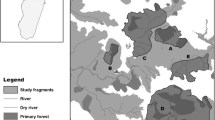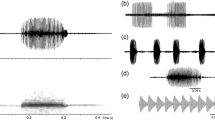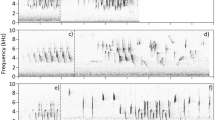Abstract
The advertisement call of Macrogenioglottus alipioi was firstly described 40 years ago from Santa Teresa municipality, Espírito Santo state, Brazil. With the advancement of digital recording and call analysis in bioacoustics, we redescribe the advertisement call of M. alipioi from a population close to its type locality, municipality of Uruçuca, Bahia. Additionally, we describe the release call and provide morphometric data. The advertisement call of M. alipioi consists of a simple pulsatile structured call, which can be emitted alone or in a series of 4–9 calls. The mean call duration is 0.46 ± 0.04 s (0.35–0.55 s) and dominant frequency ranges from 344.5 to 430.7 Hz (366.2 ± 37.56 Hz). The release call of M. alipioi usually has a pulsatile spindle-shaped waveform with harmonics and sidebands in the spectrum. The mean call duration is 0.175 s ± 0.067 (0.032–0.314 s) and dominant frequency ranges from 387.60 to 559.90 Hz (420.99 Hz ± 30.63 Hz). Males (95.3 ± 5.5 mm) and females (99.6 ± 7.8 mm) do not differ in body length, although they present significant differences related to morphometric variables of the hind limbs. We provide new bioacoustical and morphometric data of M. alipioi from a population close to its type locality. This information can help future studies that aim to define the range of a species that is widely distributed in the Atlantic Forest.


Similar content being viewed by others
References
Abravaya JP, Jackson JF (1978) Reproduction in Macrogenioglottus alipioi Carvalho (Anura, Leptodactylidae). Contrib Sci 298:1–9
Caramaschi U, Napoli MF (2012) Taxonomic revision of the Odontophrynus cultripes species group, with description of a new related species (Anura, Cycloramphidae). Zootaxa 3155:1–20
Carvalho AL (1946) Um novo gênero de ceratofridídeo do sudeste baiano. Bol Mus Nac NS Zool 73:1–18
Carvalho-e-Silva SP, Verdade V, Skuk G (2010) Macrogenioglottus alipioi. The IUCN Red List of Threatened Species 2010. https://doi.org/10.2305/IUCN.UK.2010-2.RLTS.T57178A11580779.en
de Sá RO, Tonini JFR, van Huss H, Long A, Cuddy T, Forlani MC, Peloso PLV, Zaher H, Haddad CFB (2019) Multiple connections between Amazonia and Atlantic Forest shaped the phylogenetic and morphological diversity of Chiasmocleis Mehely, 1904 (Anura: Microhylidae: Gastrophryninae). Mol Phylogenet Evol 130:198–210. https://doi.org/10.1016/j.ympev.2018.10.021
Dias IR, Lourenço-de-Moraes R, Solé M (2012) Description of the advertisement call and morphometry of Haddadus binotatus (Spix, 1824) from a population from southern Bahia, Brazil. North West J Zool 8:107–111
Duellman WE, Trueb L (1994) Biology of Amphibians. Johns Hopkins University Press, Baltimore
Forti LR, Silva TRA, Toledo LF (2017) The acoustic repertoire of the Atlantic Forest Rocket Frog and its consequences for taxonomy and conservation (Allobates, Aromobatidae). ZooKeys 692:141–153. https://doi.org/10.3897/zookeys.692.12187
Fouquet A, Martinez Q, Zeidler L, Courtois EA, Gaucher P, Blanc M, Lima JD, Souza SM, Rodrigues MT, Kok PJR (2016) Cryptic diversity in the Hypsiboas semilineatus species group (Amphibia, Anura) with the description of a new species from the eastern Guiana Shield. Zootaxa 4084:79–104. https://doi.org/10.11646/zootaxa.4084.1.3
Frost DR (2019) Amphibian species of the World: an online reference. American Museum of Natural History. http://research.amnh.org/herpetology/amphibia/index.html. Accessed 1 Nov 2019
Gehara M, Canedo C, Haddad CFB, Vences M (2013) From widespread to microendemic: molecular and acoustic analyses show that Ischnocnema guentheri (Amphibia: Brachycephalidae) is endemic to Rio de Janeiro, Brazil. Conserv Genet 14:973–982. https://doi.org/10.1007/s10592-013-0488-5
Gehara M, Barth A, Oliveira EF, Costa MA, Haddad CFB, Vences M (2017) Model-based analyses reveal insular population diversification and cryptic frog species in the Ischnocnema parva complex in the Atlantic forest of Brazil. Mol Phylogenet Evol 112:68–78. https://doi.org/10.1016/j.ympev.2017.04.007
Grenat PR, Salas NE, Martino AL (2012) Variación morfométrica intra e interespecífica entre poblaciones de Odontophrynus (Anura: Cycloramphidae) del área central de Argentina. Rev Biol Trop 60:1589–1601
Grenat PR, Martino AL (2013) The release call as a diagnostic character between cryptic related species Odontophrynus cordobae and O. Americanus (Anura: Cycloramphidae). Zootaxa 3635:583–586. https://doi.org/10.11646/zootaxa.3635.5.8
Haddad CFB, Toledo LF, Prado CPA, Loebmann D, Gasparini JL, Sazima I (2013) Guia dos anfíbios da Mata Atlântica – diversidade e biologia. Anolis Books, São Paulo
Hammer Ø, Harper DAT, Ryan PD (2001) PAST: Paleontological statistics software package for education and data analysis. Palaeontol Electron 4(1):1–9
Köhler J, Jansen M, Rodríguez A, Kok PJR, Toledo LF, Emmrich M, Glaw F, Haddad CFB, Rödel MO, Vences M (2017) The use of bioacoustics in anuran taxonomy: theory, terminology, methods and recommendations for best practice. Zootaxa 4251:1–124. https://doi.org/10.11646/zootaxa.4251.1.1
Kok PJR, Kalamandeen M (2008) Introduction to the taxonomy of the amphibians of Kaieteur National Park, Guyana. Abc Taxa, Brussels
Lavilla EO, Rougés M (1992) Reproducción y desarrollo de anuros Argentinos. Asociación Herpetológica Argentina 5:1–66
Littlejohn MJ (2001) Patterns of differentiation in temporal properties of acoustic signals of anurans. In: Ryan MJ (ed) Anuran communication. Smithsonian Institution Press, Washington, pp 102–120
Martino AL, Dehling JM, Sinsch U (2019) Integrative taxonomic reassessment of Odontophrynus populations in Argentina and phylogenetic relationships within Odontophrynidae. (Anura) PeerJ 7(e6480):1–32. https://doi.org/10.7717/peerj.6480
Mira-Mendes CV, Ruas DS, Lourenço-de-Moraes R, Rödder D, Solé M (2012) The advertisement call of Gastrotheca fissipes Boulenger, 1888 (Anura, Hemiphractidae) with comments on its distribution. Zootaxa 3312:62–64. https://doi.org/10.11646/zootaxa.3312.1.4
Orrico VGD, Nunes I, Mattedi C, Fouquet A, Lemos AW, Rivera-Correa M, Lyra ML, Loebmann D, Pimenta BVS, Caramaschi U, Rodrigues MT, Haddad CFB (2017) Integrative taxonomy supports the existence of two distinct species within Hypsiboas crepitans (Anura: Hylidae). Salamandra 53:99–113
Orrico VGD, Dias IR, Marciano E (2018) Another new species of Phyllodytes (Anura: Hylidae) from the Atlantic Forest of northeastern Brazil. Zootaxa 4407:101–110. https://doi.org/10.11646/zootaxa.4407.1.6
Pesarakloo A, Najibzadeh M, Rastegar-Pouyani N, Rastegar-Pouyani E (2018) Taxonomic survey of water frog populations of Pelophylax bedriagae (Anura: Ranidae) in western Iran: a morphometric and bioacoustic approach. Biologia 73:673–681. https://doi.org/10.2478/s11756-018-0077-7
Prado GM, Pombal JP Jr (2008) Espécies de Proceratophrys Miranda-Ribeiro, 1920 com apendices palpebrais (Anura; Cycloramphidae). Arq Zool 39:1–85
Pyron RA, Wiens JJ (2011) A large-scale phylogeny of Amphibia including over 2800 species, and a revised classification of advanced frogs, salamanders, and caecilians. Mol Phylogenetics Evol 61:543–583. https://doi.org/10.1016/j.ympev.2011.06.012
Quiroga LB, Sanabria EA, Marangoni F (2015) Sexual size dimorphism and age in Odontophrynus cf. barrioi (Anura: Odontophrynidae) from the Monte Desert, Argentina. J Herp 49(4):627–632. https://doi.org/10.1670/13-216
Rocha PC, Sena LMF, Pezzuti TL, Leite FSF, Svartman M, Rosset SD, Baldo D, Garcia CP (2017) A new diploid species belonging to the Odontophrynus americanus species group (Anura: Odontophrynidae) from the Espinhaço range, Brazil. Zootaxa 4329:327–350. https://doi.org/10.11646/zootaxa.4329.4.2
Rosset SD (2008) New Species of Odontophrynus Reinhardt and Lutken 1862 (Anura: Neobatrachia) from Brazil and Uruguay. J Herpetol 42:134–144. https://doi.org/10.1670/07-088R1.1
Ruas DS, Mira-Mendes CV, Dias IR, Solé M (2012) Description of the advertisement call of Dendropsophus haddadi (Bastos and Pombal 1996) (Anura: Hylidae) from southern Bahia. Brazil Zootaxa 3250:63–65. https://doi.org/10.11646/zootaxa.3250.1.5
Sant’Anna AC, Oliveira AFS, Santana DJ (2016) Release call of Odontophrynus cultripes Reinhardt and Lütken, 1862 (Anura: Odontophrynidae) from Southeastern Brazil. Bol Mus Biol Mello Leitão 38:275–282
Taucce PPG, Canedo C, Parreiras JS, Drummond LO, Nogueira-Costa P, Haddad CFB (2018) Molecular phylogeny of Ischnocnema (Anura: Brachycephalidae) with the redefinition of its series and the description of two new species. Mol Phylogenet Evol 128:123–146. https://doi.org/10.1016/j.ympev.2018.06.042
Zar JH (1984) Biostatistical analysis, 2nd edn. Prentice-Hall Inc, Englewood Cliffs
Acknowledgements
This study was financed in part by the Coordenação de Aperfeiçoamento de Pessoal de Nível Superior – Brasil (CAPES)/Alexander Von Humboldt Foundation through an “experienced researcher” grant issued to MS. It is also part of the working group “Large Scale automated acoustic monitoring of anuran amphibians” promoted by the National Institute for Science and Technology (INCT) in Ecology, Evolution and Biodiversity Conservation, supported by MCTIC/CNPq and FAPEG. Work by MS is supported by a CNPq productivity fellowship. Scholarships were provided by CNPq (CNPq–Project: 406899/2017-7, Process: 167387/2017-0 and 155198/2018-1) to IRD. CVMM is grateful to CAPES for a fellowships (process PNPD/1682788) and particular thanks to his wife Fernanda Tonolli and son Francisco Tonolli Mendes for their patience, affection and eternal loving support.
Author information
Authors and Affiliations
Contributions
Recordings in the field were done by CVMM, IRD and RAM. Acoustic analysis was performed by GTJ, and GNF. CVMM wrote the first draft with the aid of IRD, RAM, GTJ, GNF, YLP and MS. All authors approved the final version of the manuscript.
Corresponding author
Ethics declarations
Ethical approval
The project during which the recordings were made was approved by the Ethics Committee on Animal Use of the State University of Santa Cruz (protocol 027/16).
Conflict of Interest
The authors declare that they have no conflict of interest.
Appendix 1. Specimens examined.
Appendix 1. Specimens examined.
Macrogenioglottus alipioi: BRAZIL: BAHIA: Ilhéus (topotypes): MZUESC 7510, 13516, 19086, 20401-403, 20405-407; Una: MZUESC 10400; Uruçuca: MZUESC 17899, 17917, 18213, 20404.
Rights and permissions
About this article
Cite this article
de Mira-Mendes, C.V., Dias, I.R., Silva, G.T. et al. The advertisement and release call of the Bahia forest frog Macrogenioglottus alipioi (Anura: Odontophrynidae) with comments on its morphometry, from southern Bahia, northeastern Brazil. Biologia 75, 2271–2276 (2020). https://doi.org/10.2478/s11756-020-00488-w
Received:
Accepted:
Published:
Issue Date:
DOI: https://doi.org/10.2478/s11756-020-00488-w




